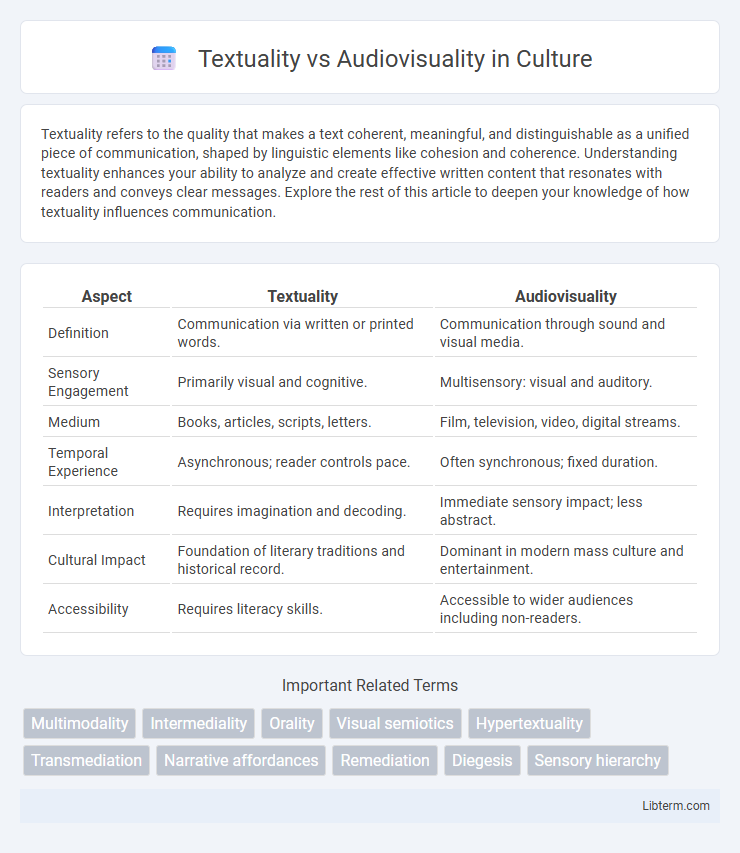Textuality refers to the quality that makes a text coherent, meaningful, and distinguishable as a unified piece of communication, shaped by linguistic elements like cohesion and coherence. Understanding textuality enhances your ability to analyze and create effective written content that resonates with readers and conveys clear messages. Explore the rest of this article to deepen your knowledge of how textuality influences communication.
Table of Comparison
| Aspect | Textuality | Audiovisuality |
|---|---|---|
| Definition | Communication via written or printed words. | Communication through sound and visual media. |
| Sensory Engagement | Primarily visual and cognitive. | Multisensory: visual and auditory. |
| Medium | Books, articles, scripts, letters. | Film, television, video, digital streams. |
| Temporal Experience | Asynchronous; reader controls pace. | Often synchronous; fixed duration. |
| Interpretation | Requires imagination and decoding. | Immediate sensory impact; less abstract. |
| Cultural Impact | Foundation of literary traditions and historical record. | Dominant in modern mass culture and entertainment. |
| Accessibility | Requires literacy skills. | Accessible to wider audiences including non-readers. |
Understanding Textuality: Definitions and Key Features
Textuality encompasses the properties and characteristics that define a written or printed text, including its structure, coherence, and context, which enable meaningful communication. Key features of textuality involve intertextuality, thematic unity, and linguistic cohesion that contribute to a text's interpretative depth. Understanding textuality requires analyzing how these elements function to produce meaning within specific cultural and communicative frameworks.
The Rise of Audiovisuality: An Overview
The rise of audiovisuality marks a significant shift in communication, emphasizing visual and auditory stimuli over traditional textual formats to enhance engagement and comprehension. This transformation is driven by advancements in digital technology, enabling immersive experiences through video, sound, and interactive media across platforms like social networks, streaming services, and virtual reality. Audiovisual content leverages cognitive processing benefits by combining sensory inputs, making information more accessible and impactful in education, marketing, and entertainment domains.
Cognitive Processing: Reading vs. Viewing
Textuality engages cognitive processing through linear decoding, relying on phonemic awareness, syntactic parsing, and semantic integration to construct meaning from written language. Audiovisuality leverages dual-channel processing by combining auditory and visual stimuli, enhancing memory retention and comprehension via multisensory integration. Reading demands active mental simulation and inferencing, while viewing often provides immediate contextual cues that reduce cognitive load but may limit deep interpretative engagement.
Engaging the Senses: Visual, Auditory, and Linguistic Modes
Engaging the senses through textuality involves activating linguistic modes that stimulate imagination and cognitive processing, while audiovisuality simultaneously targets visual and auditory senses for immediate, multisensory experiences. Textuality relies on symbolic language and reader interpretation to evoke imagery and emotions, whereas audiovisual media combine imagery, sound, and language to create immersive environments. This multimodal integration enhances sensory engagement by blending visual storytelling, soundscapes, and linguistic narratives, catering to diverse perceptual channels.
Audience Interpretation: From Words to Images
Audience interpretation shifts significantly from textuality to audiovisuality as the cognitive process moves from decoding words to processing multisensory stimuli. Textuality relies on linguistic structures and personal imagination, engaging readers in constructing meaning through language-based cues and cultural context. Audiovisuality combines visual imagery, sound, and motion, allowing audiences to interpret narratives more immediately and emotionally, often invoking a stronger sensory and emotional response compared to text.
Narrative Structures in Text and Audiovisual Media
Narrative structures in textual media rely heavily on linear progression, detailed descriptions, and internal monologues to convey plot and character development, engaging readers through imagination and interpretation. Audiovisual media employs visual and auditory elements such as camera angles, editing, sound effects, and music to create multisensory narratives, allowing for more immediate emotional impact and dynamic storytelling. The interplay between textuality and audiovisuality highlights different cognitive processes, with textual narratives emphasizing linguistic and symbolic understanding, while audiovisual narratives leverage sensory perception and temporal synchronization.
Accessibility and Inclusivity: Text vs. Audiovisual Formats
Textuality enhances accessibility by supporting screen readers and offering adjustable font sizes, benefiting individuals with visual impairments or reading difficulties. Audiovisual formats provide inclusivity through captions, sign language interpretation, and audio descriptions, catering to diverse sensory needs and learning preferences. Combining both modalities ensures comprehensive access, bridging gaps in communication for people with varied disabilities and cognitive styles.
Cultural Impact: Textuality and Audiovisuality in Society
Textuality shapes cultural identity by preserving language, history, and traditional narratives through written forms, fostering critical thinking and deeper cognitive engagement. Audiovisuality, through films, television, and digital media, drives cultural diffusion by making information and entertainment more accessible, influencing social norms and collective memory. The interplay between textuality and audiovisuality reflects evolving communication patterns that transform cultural consumption and societal interaction.
Hybrid Formats: Blurring the Lines Between Text and Audiovisuals
Hybrid formats integrate textual and audiovisual elements to create immersive communication experiences that enhance understanding and engagement. These formats leverage multimedia tools such as interactive subtitles, video annotations, and multimedia storytelling to dissolve traditional media boundaries. By combining written narratives with sound, images, and video, hybrid content caters to diverse learning styles and enriches the semantic depth of information delivery.
Future Trends: The Evolution of Media Consumption
Future trends in media consumption indicate a significant shift toward integrated audiovisual platforms that blend text, sound, and imagery for immersive experiences. Advancements in augmented reality (AR) and virtual reality (VR) are transforming storytelling by enabling interactive narratives that surpass traditional textual or purely audiovisual formats. This evolution emphasizes multimodal content, reflecting changing audience preferences for dynamic engagement and personalized media consumption across diverse digital devices.
Textuality Infographic

 libterm.com
libterm.com